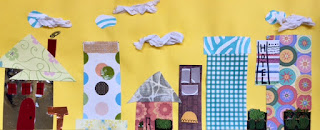 |
| Wayne Thiebaud, Cakes (1963) |
The following class, we used our recent experience with mixing colors to paint our favorite desserts! We thought about how we could mix a variety of colors, thinking about the bright colors that Thiebaud uses in his painting, as well as using white to create lighter tints of a color.
Students painted their desserts, incorporating tints, and the following week, they added additional details on top, now that the first layer of paint had dried. Students thought about how they could decorate their cakes, ice cream cones, sundaes and doughnuts with creative details like frosting, sprinkles, flowers, candles and hot fudge.
During the next class, students painted the background, considering the use of a complementary colors and colors that would help their desserts to stand out. Since Thiebaud is also known for his use of strong shadows, we looked at cast shadows and how the shape of the object changes the shape of the shadow. Students added a colorful shadow to their dessert, and many students actually chose to add a window in their background to show a light source.
For our last class, students participated in a gallery walk to see everyone's artwork and also a turn and talk to share their work with a partner. Here are some colorful examples of our delectable Wayne Thiebaud inspired desserts:
 |
| Andrew, 3rd Grade (Monfette) |
 |
| Artem, 3rd Grade (Stone) |
 |
| Brixton, 3rd Grade (Stone) |
 |
| Desmond, 3rd Grade (Fletcher Nickl) |
 |
| Evan, 3rd Grade (Monfette) |
 |
| Gavin, 3rd Grade (Fletcher Nickl) |
 |
| Pedro, 3rd Grade (Monfette) |
 |
| Priya, 3rd Grade (Monfette) |
 |
| Siobhan, 3rd Grade (Fletcher Nickl) |
 |
| Yulissa, 3rd Grade (Monfette) |
 | ||
Zerihun, 3rd Grade (Fletcher Nickl)
|
































